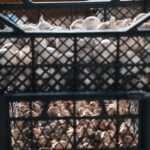Flying nocturnal insects whose larvae attack vegetable gardens are a common menace for many gardeners. These pests can wreak havoc on vegetable crops, causing significant damage and reducing the overall yield. It is crucial for gardeners to understand the impact of these flying nocturnal insects and take proactive measures to address the issue.
The presence of flying nocturnal insects in vegetable gardens can have detrimental effects on the health and yield of crops. Identifying the culprits responsible for attacking vegetable gardens is essential in implementing effective control measures. By understanding their behavior and lifecycle, gardeners can better protect their valuable produce from these destructive pests.
In this article, we will explore the various types of flying nocturnal insects that pose a threat to vegetable gardens, as well as their appearance and behavior. Additionally, we will delve into the lifecycle of these insects and how their larvae contribute to damaging vegetable crops. Understanding the signs of infestation and implementing prevention and control measures are vital in protecting your beloved vegetable garden from these harmful pests.
Identifying the Culprits
When it comes to maintaining a healthy vegetable garden, one of the most significant challenges that gardeners face is the presence of flying nocturnal insects whose larvae attack vegetable gardens. These pests can wreak havoc on the crops, causing damage that affects both the health and yield of the vegetables. Therefore, it is crucial for gardeners to be able to identify these culprits and understand their behavior in order to effectively address this issue.
The most common flying nocturnal insects that are known for attacking vegetable gardens include moth species such as cutworm moths, armyworm moths, and corn earworm moths. These pests are typically small in size with dull-colored wings, making them difficult to spot during the day.
However, their presence becomes evident at night when they are actively feeding on the leaves and fruits of vegetables. It is essential for gardeners to be able to distinguish these insects from other harmless species commonly found in gardens in order to implement targeted control measures.
In addition to their appearance, understanding the behavior of these flying nocturnal insects is also important for identification purposes. These pests are predominantly active during nighttime hours, which means that their presence may go unnoticed by gardeners who primarily tend to their plants during the day. By familiarizing themselves with the typical behavior patterns of these insects, gardeners can develop strategies for monitoring and managing infestations more effectively.
| Flying Nocturnal Insect | Description |
|---|---|
| Cutworm Moth | Small moth with dull-colored wings; larvae feed on stems of young plants |
| Armyworm Moth | Nocturnal pest with mottled gray-brown wings; caterpillars feed voraciously on foliage |
| Corn Earworm Moth | Larger moth with distinctive markings; larvae target corn ears and other vegetables |
Lifecycle of the Insects
Flying nocturnal insects, such as moths and beetles, have a complex lifecycle that contributes to their impact on vegetable gardens. Understanding the lifecycle of these insects is crucial in devising effective control measures to protect vegetable crops from infestation.
Detailed Explanation of the Lifecycle
The lifecycle of flying nocturnal insects typically includes four stages: egg, larva (or caterpillar), pupa, and adult. The eggs are usually laid on or near host plants by the adult insects. Once hatched, the larvae begin feeding on the leaves, stems, and roots of vegetable crops. As they grow, the larvae go through several molts before entering the pupal stage, where they develop into adults. The adults emerge from pupae and start the cycle again by laying eggs.
Impact of Larvae on Vegetable Gardens
The larvae of flying nocturnal insects are particularly damaging to vegetable gardens as they voraciously consume plant tissue, leading to reduced plant vigor and yield. Some species also bore into fruits or vegetables, causing further damage. Their feeding habits can affect various parts of plants, including leaves, buds, flowers, and developing fruits. This can result in stunted growth, deformed produce, and overall diminished crop quality.
Understanding Breeding and Feeding Habits
Flying nocturnal insects typically prefer to lay their eggs on specific host plants that serve as food sources for their larvae. Understanding which plants attract these insects can help gardeners take proactive measures to minimize infestation risks.
Furthermore, identifying the preferred feeding habits of these larvae can aid in implementing targeted control methods to protect vulnerable vegetable crops. By gaining insight into their breeding patterns and dietary preferences, gardeners can improve their ability to manage populations of flying nocturnal insects effectively.
Signs of Infestation
When it comes to dealing with flying nocturnal insects whose larvae attack vegetable gardens, identifying the signs of an infestation is crucial in order to take timely action and minimize damage. Here are some key indicators that your vegetable garden may be infested with these troublesome insects:
1. Wilting or Yellowing Plants: Keep an eye out for any plants in your vegetable garden that show signs of wilting or yellowing leaves, as this could be a result of larvae feeding on the roots or stems of the plants.
2. Holes and Chewed Leaves: Inspect the foliage of your vegetable crops for irregular holes and chewed edges, as flying nocturnal insects and their larvae often consume leaves as part of their feeding behavior.
3. Presence of Moths or Adult Insects: Take note of any moths or adult flying nocturnal insects in the vicinity of your vegetable garden, particularly during the evening hours when they are most active.
It’s important to distinguish between damage caused by flying nocturnal insects and other common pests in order to properly address the infestation. While other pests like caterpillars may also leave chewed leaves, specific indicators such as wilting plants and the presence of nocturnal moths can help pinpoint the problem.
Prevention and Control Measures
Tips for Preventing Infestation
To prevent infestations of flying nocturnal insects whose larvae attack vegetable gardens, there are several precautionary measures that can be taken. First and foremost, maintaining good garden hygiene is crucial. This includes regularly removing garden debris, fallen fruits, and vegetables, as well as keeping the area around the garden free of weeds. Additionally, implementing crop rotation techniques can help disrupt the lifecycle of these insects and reduce the likelihood of infestation.
Organic and Chemical Control Methods
For those facing a severe infestation, there are various control methods available. Organic options such as neem oil, diatomaceous earth, and insecticidal soaps can be effective in managing the population of these pests. These natural solutions minimize harm to beneficial insects and do not leave harmful residues on crops. On the other hand, chemical control methods like synthetic insecticides should be used as a last resort due to their potential negative impact on the environment.
Protection of Vegetable Crops
Beyond controlling the population of flying nocturnal insects, it is essential to protect vegetable crops from infestations. Using physical barriers such as row covers or netting can prevent adult insects from laying eggs on plants while still allowing sunlight and water to reach the crops. Additionally, practicing companion planting with aromatic herbs or flowers that repel these pests can deter them from settling in your vegetable garden.
By implementing these prevention and control measures effectively, gardeners can minimize the risk of infestation by flying nocturnal insects and safeguard their vegetable crops from damage and loss.
Beneficial Predators and Natural Enemies
Flying nocturnal insects, such as moths and beetles, can pose a significant threat to vegetable gardens, as their larvae feed on plants, causing damage and reducing crop yields. However, there are natural predators and enemies that can help control the population of these destructive pests. By understanding the role of beneficial predators and natural enemies, gardeners can effectively manage infestations of flying nocturnal insects in their vegetable gardens.
One of the most effective ways to control the population of flying nocturnal insects is by attracting beneficial predators to the garden. These predators include birds, bats, and predatory insects like lacewings and parasitic wasps. By creating a welcoming environment for these natural enemies, gardeners can reduce the number of harmful insects in their gardens without resorting to chemical controls.
In addition to attracting beneficial predators, biological control methods can also be used to manage the population of flying nocturnal insects. This approach involves introducing natural enemies or using microbial agents to control pest populations. For example, releasing ladybugs or encouraging the presence of predatory ground beetles can help keep insect populations in check. Similarly, applying bacillus thuringiensis (Bt), a naturally occurring bacteria that targets specific insect larvae, can effectively reduce the number of pests in the garden.
Gardeners who implement these strategies will not only protect their vegetable crops from infestations but also contribute to maintaining a healthy ecosystem in their gardens. By harnessing the power of beneficial predators and natural enemies, it is possible to achieve sustainable pest management and ensure the continued success of vegetable gardens.
Case Studies and Success Stories
In recent years, many vegetable gardeners have been facing the challenge of managing infestations of flying nocturnal insects whose larvae attack vegetable gardens. These pests can cause significant damage to crops if left unchecked, leading to reduced yields and financial losses for farmers. However, there are success stories and case studies that demonstrate how proactive measures and effective control methods can help manage these insect infestations.
One successful case study comes from a community garden in the Midwest region of the United States. The garden had been struggling with an infestation of cutworms, a type of flying nocturnal insect whose larvae feed on the stems of young plants. By implementing integrated pest management techniques such as crop rotation, using physical barriers, and introducing natural predators such as ground beetles, the garden was able to significantly reduce the population of cutworms and protect their vegetable crops.
Another success story comes from a small-scale organic farm in Europe that faced an infestation of armyworms, another type of flying nocturnal insect whose larvae are known to devastate vegetable gardens. Through the use of pheromone traps to monitor adult populations, timely application of organic botanical insecticides, and encouraging natural enemies such as parasitic wasps and predatory beetles, the farm was able to successfully control the armyworm population without relying on chemical pesticides.
These case studies and success stories highlight the importance of proactive measures and effective control methods in managing infestations of flying nocturnal insects in vegetable gardens. By adopting a combination of preventive techniques, organic control measures, and encouraging natural predators, farmers and gardeners can protect their crops from these destructive pests while minimizing environmental impact.
| Case Study Location | Type of Flying Nocturnal Insect | Control Methods Used |
|---|---|---|
| Midwest region – United States | Cutworms | Crop rotation, physical barriers, natural predators |
| Europe | Armyworms | Pheromone traps, organic botanical insecticides, natural enemies |
Conclusion
In conclusion, the presence of flying nocturnal insects whose larvae attack vegetable gardens can have a significant impact on the health and yield of vegetable crops. As discussed in this article, these pests can cause extensive damage to plants and compromise the overall success of a garden. It is crucial for gardeners to be proactive in addressing this issue in order to protect their vegetable crops and ensure a bountiful harvest.
By identifying the culprits, understanding their lifecycle, and recognizing the signs of infestation, gardeners can take necessary steps to prevent and control the population of these damaging insects. Implementing both organic and chemical control measures, as well as attracting beneficial predators to the garden, are effective strategies for managing infestations and protecting vegetable crops from harm.
It is important for readers to remember that with dedication and proper management techniques, it is possible to overcome the challenge of insect infestations in vegetable gardens. By taking these proactive measures, gardeners can mitigate the impact of flying nocturnal insects and safeguard their gardens against potential damage. Ultimately, effective insect control plays a crucial role in determining the success of vegetable gardens, making it essential for individuals to prioritize this aspect of garden care.
Frequently Asked Questions
What Are the Larvae in My Vegetable Garden?
The larvae in your vegetable garden could be various insects such as caterpillars, beetles, or maggots. Identifying the specific larvae can help you determine the best course of action to protect your vegetables.
What Is Eating My Vegetables at Night?
If something is eating your vegetables at night, it could be nocturnal pests like slugs, snails, or even rats. Setting up traps or barriers and inspecting your garden at night can help identify the culprit.
What Does Aphid Larvae Look Like?
Aphid larvae are tiny and often green or yellow in color. They may have soft bodies and six legs. Identifying aphid larvae can help you control infestations and protect your plants from damage.

If you’re looking to get into vegetable gardening, or are just looking for some tips on how to make your current garden better, then you’ve come to the right place! My name is Ethel and I have been gardening for years. In this blog, I’m going to share with you some of my best tips on how to create a successful vegetable garden.





